Taxation Law: Share Buy-back Process and FBT Calculations
VerifiedAdded on 2023/06/05
|7
|2627
|58
AI Summary
This article discusses the share buy-back process and FBT calculations in taxation law. It explains the tax treatment and implications of off-market buy-back of shares, including the distribution of the allocated payment between the capital and dividend components. It also provides a case study on the income liability of Lucy and the FBT amount and tax liability of CCC. The article offers expert guidance on Desklib for students and professionals.
Contribute Materials
Your contribution can guide someone’s learning journey. Share your
documents today.
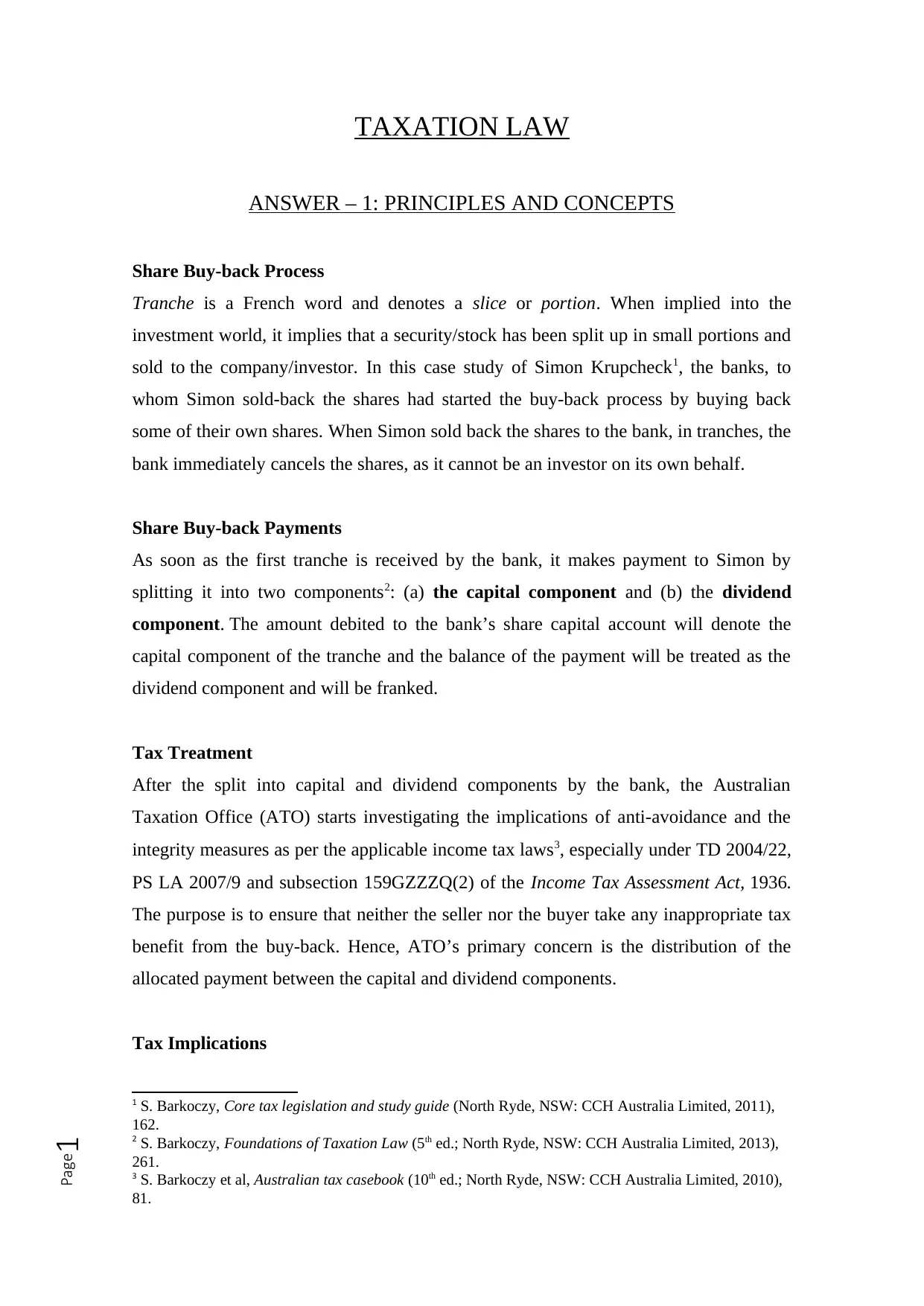
Page1
TAXATION LAW
ANSWER – 1: PRINCIPLES AND CONCEPTS
Share Buy-back Process
Tranche is a French word and denotes a slice or portion. When implied into the
investment world, it implies that a security/stock has been split up in small portions and
sold to the company/investor. In this case study of Simon Krupcheck1, the banks, to
whom Simon sold-back the shares had started the buy-back process by buying back
some of their own shares. When Simon sold back the shares to the bank, in tranches, the
bank immediately cancels the shares, as it cannot be an investor on its own behalf.
Share Buy-back Payments
As soon as the first tranche is received by the bank, it makes payment to Simon by
splitting it into two components2: (a) the capital component and (b) the dividend
component. The amount debited to the bank’s share capital account will denote the
capital component of the tranche and the balance of the payment will be treated as the
dividend component and will be franked.
Tax Treatment
After the split into capital and dividend components by the bank, the Australian
Taxation Office (ATO) starts investigating the implications of anti-avoidance and the
integrity measures as per the applicable income tax laws3, especially under TD 2004/22,
PS LA 2007/9 and subsection 159GZZZQ(2) of the Income Tax Assessment Act, 1936.
The purpose is to ensure that neither the seller nor the buyer take any inappropriate tax
benefit from the buy-back. Hence, ATO’s primary concern is the distribution of the
allocated payment between the capital and dividend components.
Tax Implications
1 S. Barkoczy, Core tax legislation and study guide (North Ryde, NSW: CCH Australia Limited, 2011),
162.
2 S. Barkoczy, Foundations of Taxation Law (5th ed.; North Ryde, NSW: CCH Australia Limited, 2013),
261.
3 S. Barkoczy et al, Australian tax casebook (10th ed.; North Ryde, NSW: CCH Australia Limited, 2010),
81.
TAXATION LAW
ANSWER – 1: PRINCIPLES AND CONCEPTS
Share Buy-back Process
Tranche is a French word and denotes a slice or portion. When implied into the
investment world, it implies that a security/stock has been split up in small portions and
sold to the company/investor. In this case study of Simon Krupcheck1, the banks, to
whom Simon sold-back the shares had started the buy-back process by buying back
some of their own shares. When Simon sold back the shares to the bank, in tranches, the
bank immediately cancels the shares, as it cannot be an investor on its own behalf.
Share Buy-back Payments
As soon as the first tranche is received by the bank, it makes payment to Simon by
splitting it into two components2: (a) the capital component and (b) the dividend
component. The amount debited to the bank’s share capital account will denote the
capital component of the tranche and the balance of the payment will be treated as the
dividend component and will be franked.
Tax Treatment
After the split into capital and dividend components by the bank, the Australian
Taxation Office (ATO) starts investigating the implications of anti-avoidance and the
integrity measures as per the applicable income tax laws3, especially under TD 2004/22,
PS LA 2007/9 and subsection 159GZZZQ(2) of the Income Tax Assessment Act, 1936.
The purpose is to ensure that neither the seller nor the buyer take any inappropriate tax
benefit from the buy-back. Hence, ATO’s primary concern is the distribution of the
allocated payment between the capital and dividend components.
Tax Implications
1 S. Barkoczy, Core tax legislation and study guide (North Ryde, NSW: CCH Australia Limited, 2011),
162.
2 S. Barkoczy, Foundations of Taxation Law (5th ed.; North Ryde, NSW: CCH Australia Limited, 2013),
261.
3 S. Barkoczy et al, Australian tax casebook (10th ed.; North Ryde, NSW: CCH Australia Limited, 2010),
81.
Secure Best Marks with AI Grader
Need help grading? Try our AI Grader for instant feedback on your assignments.
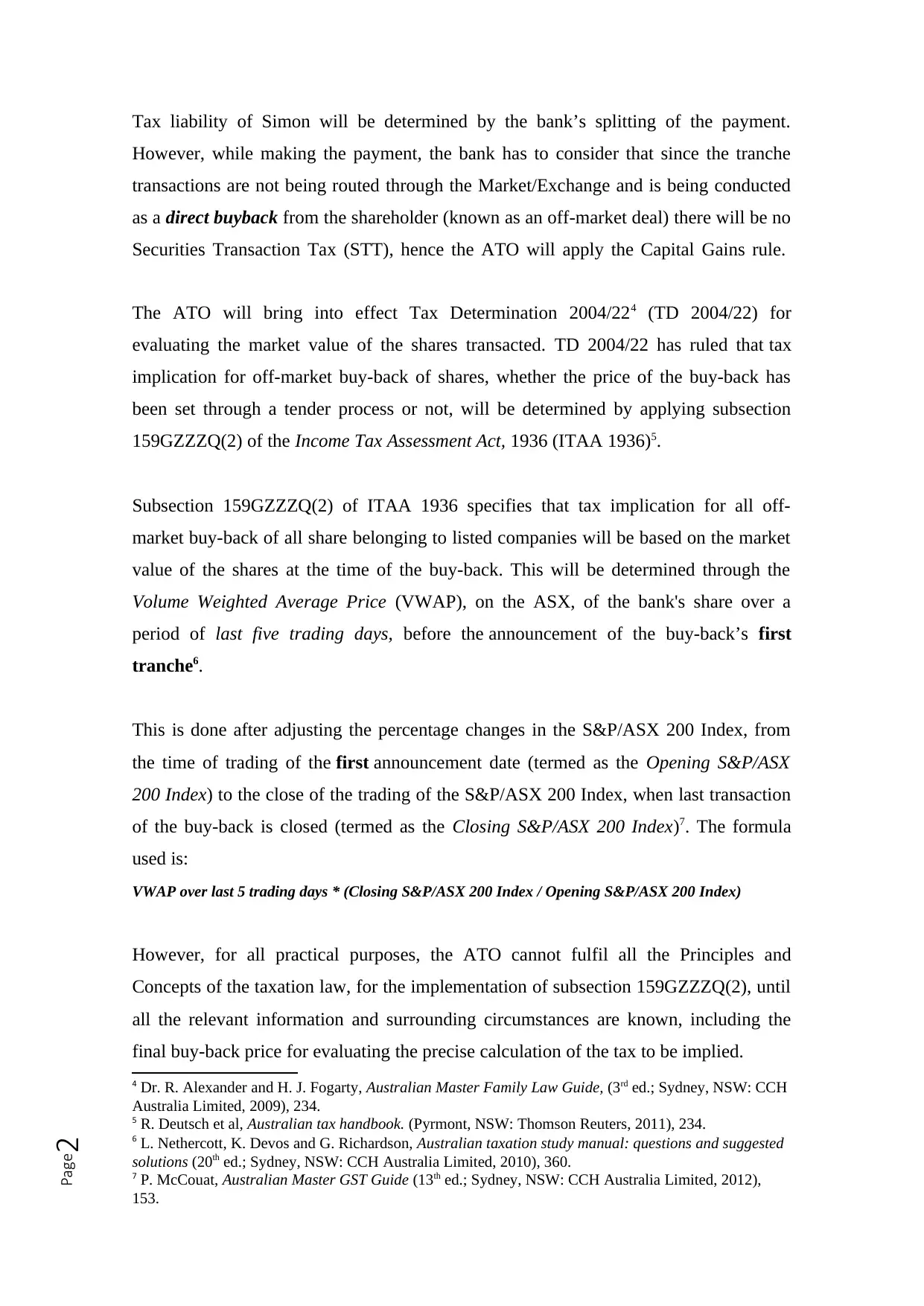
Page2
Tax liability of Simon will be determined by the bank’s splitting of the payment.
However, while making the payment, the bank has to consider that since the tranche
transactions are not being routed through the Market/Exchange and is being conducted
as a direct buyback from the shareholder (known as an off-market deal) there will be no
Securities Transaction Tax (STT), hence the ATO will apply the Capital Gains rule.
The ATO will bring into effect Tax Determination 2004/224 (TD 2004/22) for
evaluating the market value of the shares transacted. TD 2004/22 has ruled that tax
implication for off-market buy-back of shares, whether the price of the buy-back has
been set through a tender process or not, will be determined by applying subsection
159GZZZQ(2) of the Income Tax Assessment Act, 1936 (ITAA 1936)5.
Subsection 159GZZZQ(2) of ITAA 1936 specifies that tax implication for all off-
market buy-back of all share belonging to listed companies will be based on the market
value of the shares at the time of the buy-back. This will be determined through the
Volume Weighted Average Price (VWAP), on the ASX, of the bank's share over a
period of last five trading days, before the announcement of the buy-back’s first
tranche6.
This is done after adjusting the percentage changes in the S&P/ASX 200 Index, from
the time of trading of the first announcement date (termed as the Opening S&P/ASX
200 Index) to the close of the trading of the S&P/ASX 200 Index, when last transaction
of the buy-back is closed (termed as the Closing S&P/ASX 200 Index)7. The formula
used is:
VWAP over last 5 trading days * (Closing S&P/ASX 200 Index / Opening S&P/ASX 200 Index)
However, for all practical purposes, the ATO cannot fulfil all the Principles and
Concepts of the taxation law, for the implementation of subsection 159GZZZQ(2), until
all the relevant information and surrounding circumstances are known, including the
final buy-back price for evaluating the precise calculation of the tax to be implied.
4 Dr. R. Alexander and H. J. Fogarty, Australian Master Family Law Guide, (3rd ed.; Sydney, NSW: CCH
Australia Limited, 2009), 234.
5 R. Deutsch et al, Australian tax handbook. (Pyrmont, NSW: Thomson Reuters, 2011), 234.
6 L. Nethercott, K. Devos and G. Richardson, Australian taxation study manual: questions and suggested
solutions (20th ed.; Sydney, NSW: CCH Australia Limited, 2010), 360.
7 P. McCouat, Australian Master GST Guide (13th ed.; Sydney, NSW: CCH Australia Limited, 2012),
153.
Tax liability of Simon will be determined by the bank’s splitting of the payment.
However, while making the payment, the bank has to consider that since the tranche
transactions are not being routed through the Market/Exchange and is being conducted
as a direct buyback from the shareholder (known as an off-market deal) there will be no
Securities Transaction Tax (STT), hence the ATO will apply the Capital Gains rule.
The ATO will bring into effect Tax Determination 2004/224 (TD 2004/22) for
evaluating the market value of the shares transacted. TD 2004/22 has ruled that tax
implication for off-market buy-back of shares, whether the price of the buy-back has
been set through a tender process or not, will be determined by applying subsection
159GZZZQ(2) of the Income Tax Assessment Act, 1936 (ITAA 1936)5.
Subsection 159GZZZQ(2) of ITAA 1936 specifies that tax implication for all off-
market buy-back of all share belonging to listed companies will be based on the market
value of the shares at the time of the buy-back. This will be determined through the
Volume Weighted Average Price (VWAP), on the ASX, of the bank's share over a
period of last five trading days, before the announcement of the buy-back’s first
tranche6.
This is done after adjusting the percentage changes in the S&P/ASX 200 Index, from
the time of trading of the first announcement date (termed as the Opening S&P/ASX
200 Index) to the close of the trading of the S&P/ASX 200 Index, when last transaction
of the buy-back is closed (termed as the Closing S&P/ASX 200 Index)7. The formula
used is:
VWAP over last 5 trading days * (Closing S&P/ASX 200 Index / Opening S&P/ASX 200 Index)
However, for all practical purposes, the ATO cannot fulfil all the Principles and
Concepts of the taxation law, for the implementation of subsection 159GZZZQ(2), until
all the relevant information and surrounding circumstances are known, including the
final buy-back price for evaluating the precise calculation of the tax to be implied.
4 Dr. R. Alexander and H. J. Fogarty, Australian Master Family Law Guide, (3rd ed.; Sydney, NSW: CCH
Australia Limited, 2009), 234.
5 R. Deutsch et al, Australian tax handbook. (Pyrmont, NSW: Thomson Reuters, 2011), 234.
6 L. Nethercott, K. Devos and G. Richardson, Australian taxation study manual: questions and suggested
solutions (20th ed.; Sydney, NSW: CCH Australia Limited, 2010), 360.
7 P. McCouat, Australian Master GST Guide (13th ed.; Sydney, NSW: CCH Australia Limited, 2012),
153.
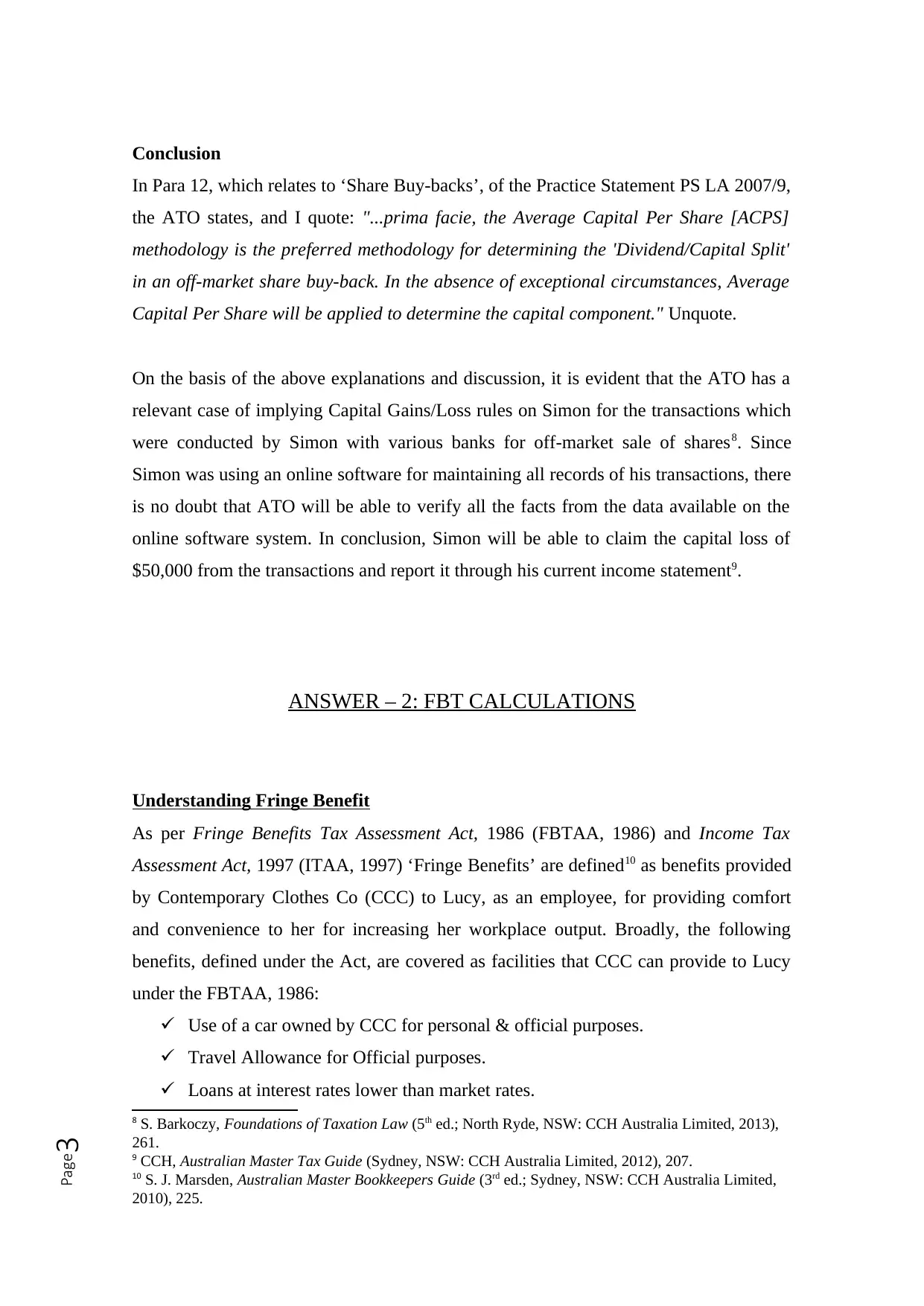
Page3
Conclusion
In Para 12, which relates to ‘Share Buy-backs’, of the Practice Statement PS LA 2007/9,
the ATO states, and I quote: "...prima facie, the Average Capital Per Share [ACPS]
methodology is the preferred methodology for determining the 'Dividend/Capital Split'
in an off-market share buy-back. In the absence of exceptional circumstances, Average
Capital Per Share will be applied to determine the capital component." Unquote.
On the basis of the above explanations and discussion, it is evident that the ATO has a
relevant case of implying Capital Gains/Loss rules on Simon for the transactions which
were conducted by Simon with various banks for off-market sale of shares8. Since
Simon was using an online software for maintaining all records of his transactions, there
is no doubt that ATO will be able to verify all the facts from the data available on the
online software system. In conclusion, Simon will be able to claim the capital loss of
$50,000 from the transactions and report it through his current income statement9.
ANSWER – 2: FBT CALCULATIONS
Understanding Fringe Benefit
As per Fringe Benefits Tax Assessment Act, 1986 (FBTAA, 1986) and Income Tax
Assessment Act, 1997 (ITAA, 1997) ‘Fringe Benefits’ are defined10 as benefits provided
by Contemporary Clothes Co (CCC) to Lucy, as an employee, for providing comfort
and convenience to her for increasing her workplace output. Broadly, the following
benefits, defined under the Act, are covered as facilities that CCC can provide to Lucy
under the FBTAA, 1986:
Use of a car owned by CCC for personal & official purposes.
Travel Allowance for Official purposes.
Loans at interest rates lower than market rates.
8 S. Barkoczy, Foundations of Taxation Law (5th ed.; North Ryde, NSW: CCH Australia Limited, 2013),
261.
9 CCH, Australian Master Tax Guide (Sydney, NSW: CCH Australia Limited, 2012), 207.
10 S. J. Marsden, Australian Master Bookkeepers Guide (3rd ed.; Sydney, NSW: CCH Australia Limited,
2010), 225.
Conclusion
In Para 12, which relates to ‘Share Buy-backs’, of the Practice Statement PS LA 2007/9,
the ATO states, and I quote: "...prima facie, the Average Capital Per Share [ACPS]
methodology is the preferred methodology for determining the 'Dividend/Capital Split'
in an off-market share buy-back. In the absence of exceptional circumstances, Average
Capital Per Share will be applied to determine the capital component." Unquote.
On the basis of the above explanations and discussion, it is evident that the ATO has a
relevant case of implying Capital Gains/Loss rules on Simon for the transactions which
were conducted by Simon with various banks for off-market sale of shares8. Since
Simon was using an online software for maintaining all records of his transactions, there
is no doubt that ATO will be able to verify all the facts from the data available on the
online software system. In conclusion, Simon will be able to claim the capital loss of
$50,000 from the transactions and report it through his current income statement9.
ANSWER – 2: FBT CALCULATIONS
Understanding Fringe Benefit
As per Fringe Benefits Tax Assessment Act, 1986 (FBTAA, 1986) and Income Tax
Assessment Act, 1997 (ITAA, 1997) ‘Fringe Benefits’ are defined10 as benefits provided
by Contemporary Clothes Co (CCC) to Lucy, as an employee, for providing comfort
and convenience to her for increasing her workplace output. Broadly, the following
benefits, defined under the Act, are covered as facilities that CCC can provide to Lucy
under the FBTAA, 1986:
Use of a car owned by CCC for personal & official purposes.
Travel Allowance for Official purposes.
Loans at interest rates lower than market rates.
8 S. Barkoczy, Foundations of Taxation Law (5th ed.; North Ryde, NSW: CCH Australia Limited, 2013),
261.
9 CCH, Australian Master Tax Guide (Sydney, NSW: CCH Australia Limited, 2012), 207.
10 S. J. Marsden, Australian Master Bookkeepers Guide (3rd ed.; Sydney, NSW: CCH Australia Limited,
2010), 225.
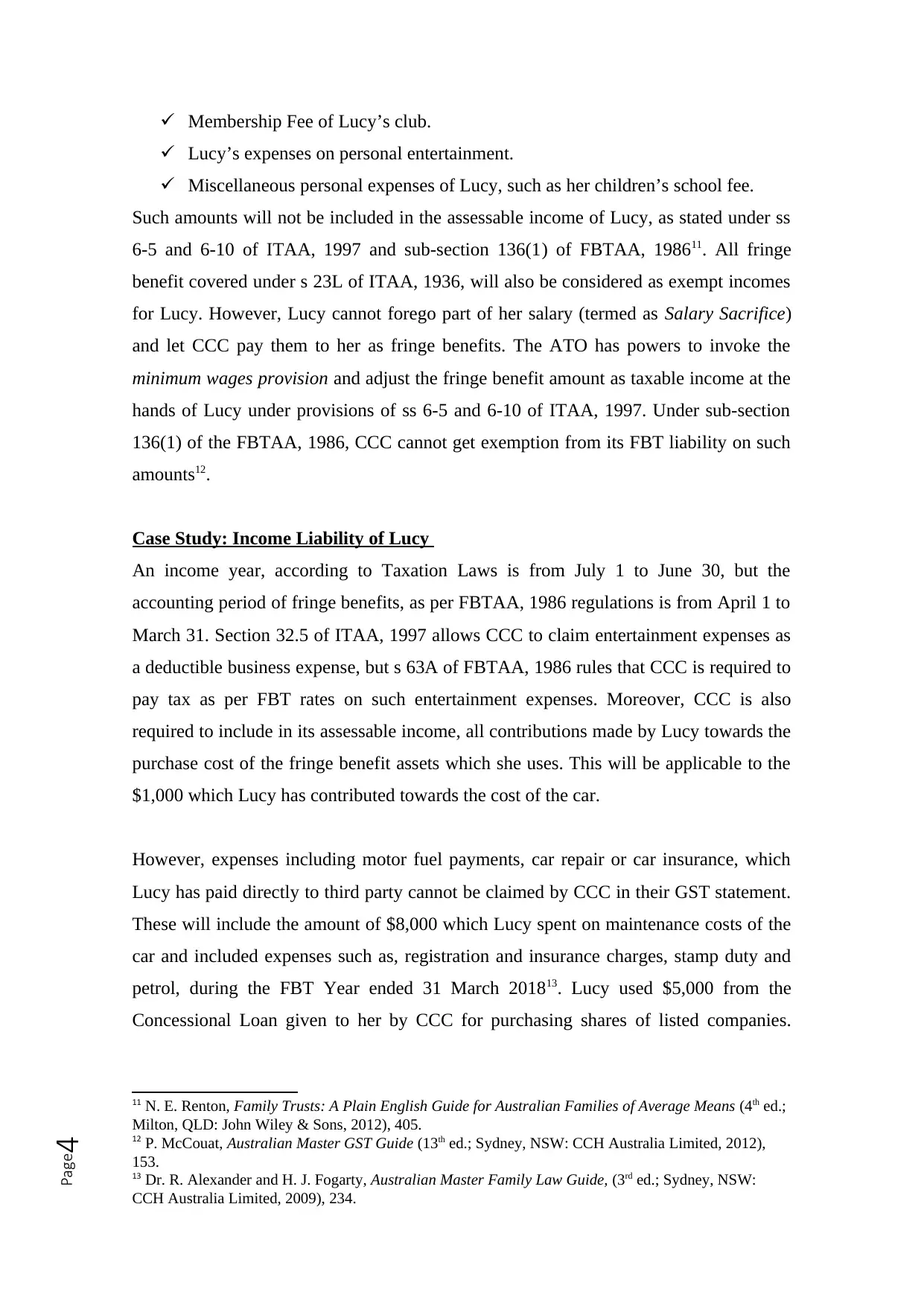
Page4
Membership Fee of Lucy’s club.
Lucy’s expenses on personal entertainment.
Miscellaneous personal expenses of Lucy, such as her children’s school fee.
Such amounts will not be included in the assessable income of Lucy, as stated under ss
6-5 and 6-10 of ITAA, 1997 and sub-section 136(1) of FBTAA, 198611. All fringe
benefit covered under s 23L of ITAA, 1936, will also be considered as exempt incomes
for Lucy. However, Lucy cannot forego part of her salary (termed as Salary Sacrifice)
and let CCC pay them to her as fringe benefits. The ATO has powers to invoke the
minimum wages provision and adjust the fringe benefit amount as taxable income at the
hands of Lucy under provisions of ss 6-5 and 6-10 of ITAA, 1997. Under sub-section
136(1) of the FBTAA, 1986, CCC cannot get exemption from its FBT liability on such
amounts12.
Case Study: Income Liability of Lucy
An income year, according to Taxation Laws is from July 1 to June 30, but the
accounting period of fringe benefits, as per FBTAA, 1986 regulations is from April 1 to
March 31. Section 32.5 of ITAA, 1997 allows CCC to claim entertainment expenses as
a deductible business expense, but s 63A of FBTAA, 1986 rules that CCC is required to
pay tax as per FBT rates on such entertainment expenses. Moreover, CCC is also
required to include in its assessable income, all contributions made by Lucy towards the
purchase cost of the fringe benefit assets which she uses. This will be applicable to the
$1,000 which Lucy has contributed towards the cost of the car.
However, expenses including motor fuel payments, car repair or car insurance, which
Lucy has paid directly to third party cannot be claimed by CCC in their GST statement.
These will include the amount of $8,000 which Lucy spent on maintenance costs of the
car and included expenses such as, registration and insurance charges, stamp duty and
petrol, during the FBT Year ended 31 March 201813. Lucy used $5,000 from the
Concessional Loan given to her by CCC for purchasing shares of listed companies.
11 N. E. Renton, Family Trusts: A Plain English Guide for Australian Families of Average Means (4th ed.;
Milton, QLD: John Wiley & Sons, 2012), 405.
12 P. McCouat, Australian Master GST Guide (13th ed.; Sydney, NSW: CCH Australia Limited, 2012),
153.
13 Dr. R. Alexander and H. J. Fogarty, Australian Master Family Law Guide, (3rd ed.; Sydney, NSW:
CCH Australia Limited, 2009), 234.
Membership Fee of Lucy’s club.
Lucy’s expenses on personal entertainment.
Miscellaneous personal expenses of Lucy, such as her children’s school fee.
Such amounts will not be included in the assessable income of Lucy, as stated under ss
6-5 and 6-10 of ITAA, 1997 and sub-section 136(1) of FBTAA, 198611. All fringe
benefit covered under s 23L of ITAA, 1936, will also be considered as exempt incomes
for Lucy. However, Lucy cannot forego part of her salary (termed as Salary Sacrifice)
and let CCC pay them to her as fringe benefits. The ATO has powers to invoke the
minimum wages provision and adjust the fringe benefit amount as taxable income at the
hands of Lucy under provisions of ss 6-5 and 6-10 of ITAA, 1997. Under sub-section
136(1) of the FBTAA, 1986, CCC cannot get exemption from its FBT liability on such
amounts12.
Case Study: Income Liability of Lucy
An income year, according to Taxation Laws is from July 1 to June 30, but the
accounting period of fringe benefits, as per FBTAA, 1986 regulations is from April 1 to
March 31. Section 32.5 of ITAA, 1997 allows CCC to claim entertainment expenses as
a deductible business expense, but s 63A of FBTAA, 1986 rules that CCC is required to
pay tax as per FBT rates on such entertainment expenses. Moreover, CCC is also
required to include in its assessable income, all contributions made by Lucy towards the
purchase cost of the fringe benefit assets which she uses. This will be applicable to the
$1,000 which Lucy has contributed towards the cost of the car.
However, expenses including motor fuel payments, car repair or car insurance, which
Lucy has paid directly to third party cannot be claimed by CCC in their GST statement.
These will include the amount of $8,000 which Lucy spent on maintenance costs of the
car and included expenses such as, registration and insurance charges, stamp duty and
petrol, during the FBT Year ended 31 March 201813. Lucy used $5,000 from the
Concessional Loan given to her by CCC for purchasing shares of listed companies.
11 N. E. Renton, Family Trusts: A Plain English Guide for Australian Families of Average Means (4th ed.;
Milton, QLD: John Wiley & Sons, 2012), 405.
12 P. McCouat, Australian Master GST Guide (13th ed.; Sydney, NSW: CCH Australia Limited, 2012),
153.
13 Dr. R. Alexander and H. J. Fogarty, Australian Master Family Law Guide, (3rd ed.; Sydney, NSW:
CCH Australia Limited, 2009), 234.
Secure Best Marks with AI Grader
Need help grading? Try our AI Grader for instant feedback on your assignments.

Page5
Lucy will be liable for any Capital Gain/Loss which she collects from the sale of these
shares.
The waiver of loan of $2,000 on 31 March 2018, given to Lucy’s husband Dave by
CCC on 1 April 2017, will be claimed as a fringe benefit by CCC and taxed
accordingly. The cost of tickets to Bali (equivalent to $3,000), which Lucy paid out of
her Frequent Flyer Points cannot be claimed by Lucy as a deductible expense, as the
Frequent Flyer Points were earned from her FBT traveling allowance paid by CCC14.
Case Study: FBT Amount of CCC
Type-1 fringe benefits are inclusive of GST. However, Type-2 fringe benefits are those
which are either exempt or excluded benefits under the provisions of FBTAA, 1986 and
hence are free from any liability under GST15.
CCC’s FBT amount can be calculated by using the following formula16.
= [(Total amount of Type-1 Fringe Benefits) x (Higher Gross-up Rate)] +
[(Total amount of Type-2 Fringe Benefits) x (Lower Gross-up rate)]
= ($(20,000 + 50,000 + 1,000) x 2.0802) + ($(10,000 + 2,000) x 1.8868)
= $(71,000 x 2.0802) + $(12,000 x 1.8868)
= $147,694.2 + $22,641.6
= $170,335.8
Case Study: Fringe Benefit Tax Liability of CCC
To calculate CCC’s Fringe Benefit Tax liability17, the amount of FBT calculated above
is to be multiplied by the applicable FBT rate of 47.0% for the FBT year ended 31
March 2018.
Hence, the Total Fringe Benefit Tax liability of CCC for the FBT Year ended 31 March
2018 will be:
= $170,335.8 x 47.0%
14 S. Barkoczy, Australian Tax Case book (9th ed.; North Ryde, NSW: CCH Australia Limited, 2012),
135.
15 J. Cassidy, Concise Income Tax (4th ed.; Annandale, NSW: Federation Press, 2007), 144.
16 R. Deutsch et al, Australian tax handbook. (Pyrmont, NSW: Thomson Reuters, 2011), 234.
17 P. McCouat, Australian Master GST Guide (13th ed.; Sydney, NSW: CCH Australia Limited, 2012),
153.
Lucy will be liable for any Capital Gain/Loss which she collects from the sale of these
shares.
The waiver of loan of $2,000 on 31 March 2018, given to Lucy’s husband Dave by
CCC on 1 April 2017, will be claimed as a fringe benefit by CCC and taxed
accordingly. The cost of tickets to Bali (equivalent to $3,000), which Lucy paid out of
her Frequent Flyer Points cannot be claimed by Lucy as a deductible expense, as the
Frequent Flyer Points were earned from her FBT traveling allowance paid by CCC14.
Case Study: FBT Amount of CCC
Type-1 fringe benefits are inclusive of GST. However, Type-2 fringe benefits are those
which are either exempt or excluded benefits under the provisions of FBTAA, 1986 and
hence are free from any liability under GST15.
CCC’s FBT amount can be calculated by using the following formula16.
= [(Total amount of Type-1 Fringe Benefits) x (Higher Gross-up Rate)] +
[(Total amount of Type-2 Fringe Benefits) x (Lower Gross-up rate)]
= ($(20,000 + 50,000 + 1,000) x 2.0802) + ($(10,000 + 2,000) x 1.8868)
= $(71,000 x 2.0802) + $(12,000 x 1.8868)
= $147,694.2 + $22,641.6
= $170,335.8
Case Study: Fringe Benefit Tax Liability of CCC
To calculate CCC’s Fringe Benefit Tax liability17, the amount of FBT calculated above
is to be multiplied by the applicable FBT rate of 47.0% for the FBT year ended 31
March 2018.
Hence, the Total Fringe Benefit Tax liability of CCC for the FBT Year ended 31 March
2018 will be:
= $170,335.8 x 47.0%
14 S. Barkoczy, Australian Tax Case book (9th ed.; North Ryde, NSW: CCH Australia Limited, 2012),
135.
15 J. Cassidy, Concise Income Tax (4th ed.; Annandale, NSW: Federation Press, 2007), 144.
16 R. Deutsch et al, Australian tax handbook. (Pyrmont, NSW: Thomson Reuters, 2011), 234.
17 P. McCouat, Australian Master GST Guide (13th ed.; Sydney, NSW: CCH Australia Limited, 2012),
153.
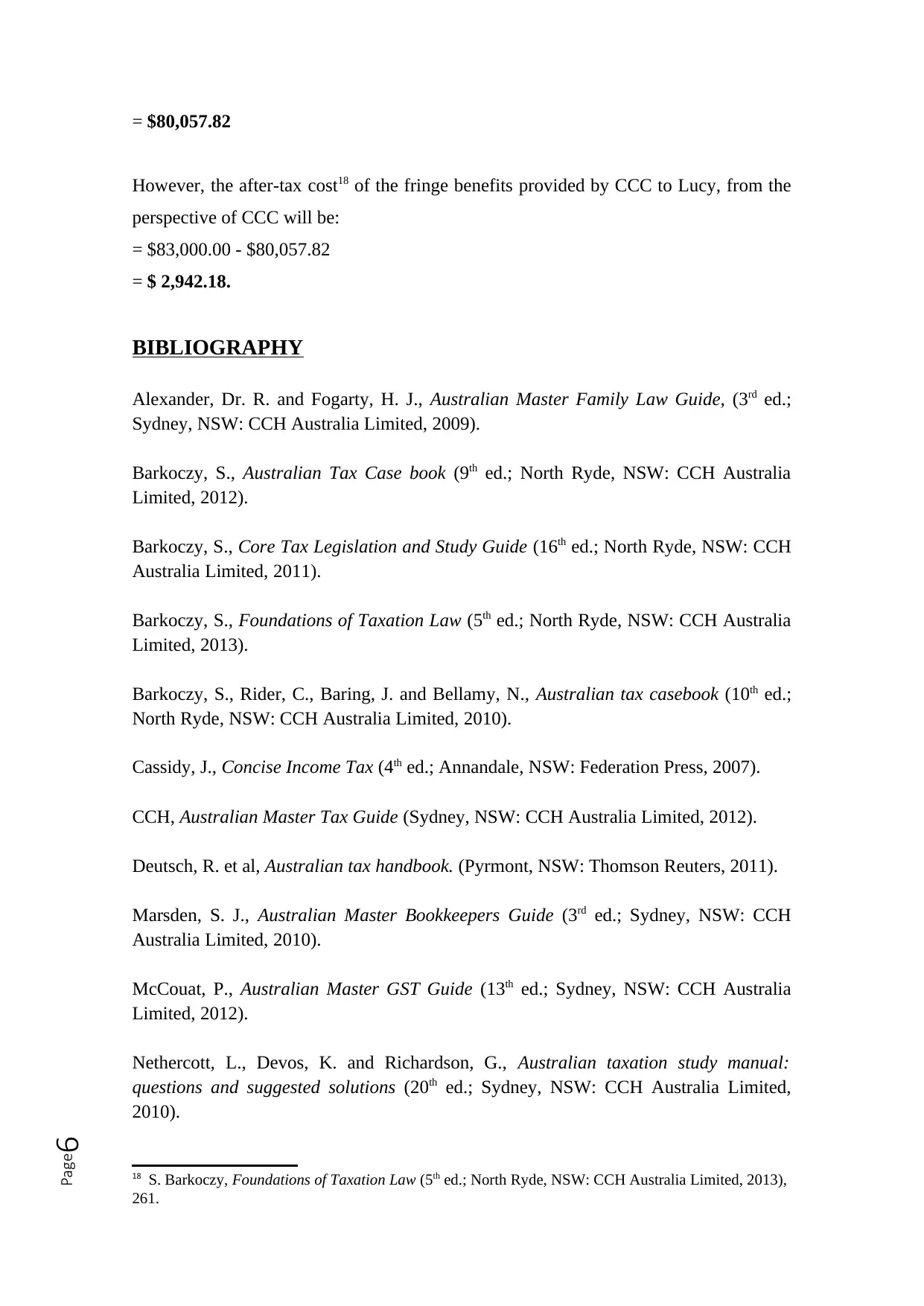
Page6
= $80,057.82
However, the after-tax cost18 of the fringe benefits provided by CCC to Lucy, from the
perspective of CCC will be:
= $83,000.00 - $80,057.82
= $ 2,942.18.
BIBLIOGRAPHY
Alexander, Dr. R. and Fogarty, H. J., Australian Master Family Law Guide, (3rd ed.;
Sydney, NSW: CCH Australia Limited, 2009).
Barkoczy, S., Australian Tax Case book (9th ed.; North Ryde, NSW: CCH Australia
Limited, 2012).
Barkoczy, S., Core Tax Legislation and Study Guide (16th ed.; North Ryde, NSW: CCH
Australia Limited, 2011).
Barkoczy, S., Foundations of Taxation Law (5th ed.; North Ryde, NSW: CCH Australia
Limited, 2013).
Barkoczy, S., Rider, C., Baring, J. and Bellamy, N., Australian tax casebook (10th ed.;
North Ryde, NSW: CCH Australia Limited, 2010).
Cassidy, J., Concise Income Tax (4th ed.; Annandale, NSW: Federation Press, 2007).
CCH, Australian Master Tax Guide (Sydney, NSW: CCH Australia Limited, 2012).
Deutsch, R. et al, Australian tax handbook. (Pyrmont, NSW: Thomson Reuters, 2011).
Marsden, S. J., Australian Master Bookkeepers Guide (3rd ed.; Sydney, NSW: CCH
Australia Limited, 2010).
McCouat, P., Australian Master GST Guide (13th ed.; Sydney, NSW: CCH Australia
Limited, 2012).
Nethercott, L., Devos, K. and Richardson, G., Australian taxation study manual:
questions and suggested solutions (20th ed.; Sydney, NSW: CCH Australia Limited,
2010).
18 S. Barkoczy, Foundations of Taxation Law (5th ed.; North Ryde, NSW: CCH Australia Limited, 2013),
261.
= $80,057.82
However, the after-tax cost18 of the fringe benefits provided by CCC to Lucy, from the
perspective of CCC will be:
= $83,000.00 - $80,057.82
= $ 2,942.18.
BIBLIOGRAPHY
Alexander, Dr. R. and Fogarty, H. J., Australian Master Family Law Guide, (3rd ed.;
Sydney, NSW: CCH Australia Limited, 2009).
Barkoczy, S., Australian Tax Case book (9th ed.; North Ryde, NSW: CCH Australia
Limited, 2012).
Barkoczy, S., Core Tax Legislation and Study Guide (16th ed.; North Ryde, NSW: CCH
Australia Limited, 2011).
Barkoczy, S., Foundations of Taxation Law (5th ed.; North Ryde, NSW: CCH Australia
Limited, 2013).
Barkoczy, S., Rider, C., Baring, J. and Bellamy, N., Australian tax casebook (10th ed.;
North Ryde, NSW: CCH Australia Limited, 2010).
Cassidy, J., Concise Income Tax (4th ed.; Annandale, NSW: Federation Press, 2007).
CCH, Australian Master Tax Guide (Sydney, NSW: CCH Australia Limited, 2012).
Deutsch, R. et al, Australian tax handbook. (Pyrmont, NSW: Thomson Reuters, 2011).
Marsden, S. J., Australian Master Bookkeepers Guide (3rd ed.; Sydney, NSW: CCH
Australia Limited, 2010).
McCouat, P., Australian Master GST Guide (13th ed.; Sydney, NSW: CCH Australia
Limited, 2012).
Nethercott, L., Devos, K. and Richardson, G., Australian taxation study manual:
questions and suggested solutions (20th ed.; Sydney, NSW: CCH Australia Limited,
2010).
18 S. Barkoczy, Foundations of Taxation Law (5th ed.; North Ryde, NSW: CCH Australia Limited, 2013),
261.
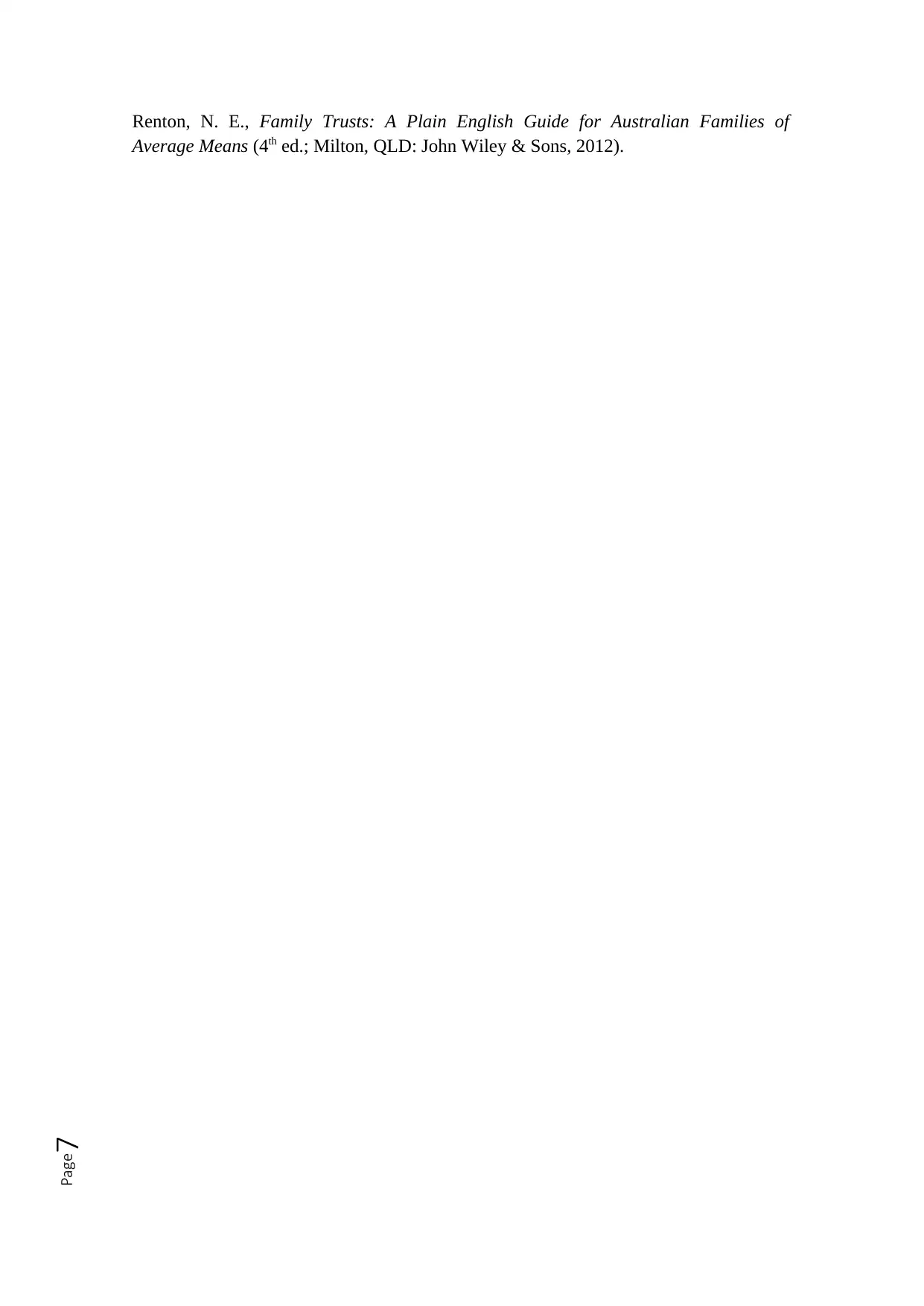
Page7
Renton, N. E., Family Trusts: A Plain English Guide for Australian Families of
Average Means (4th ed.; Milton, QLD: John Wiley & Sons, 2012).
Renton, N. E., Family Trusts: A Plain English Guide for Australian Families of
Average Means (4th ed.; Milton, QLD: John Wiley & Sons, 2012).
1 out of 7
Your All-in-One AI-Powered Toolkit for Academic Success.
+13062052269
info@desklib.com
Available 24*7 on WhatsApp / Email
![[object Object]](/_next/static/media/star-bottom.7253800d.svg)
Unlock your academic potential
© 2024 | Zucol Services PVT LTD | All rights reserved.